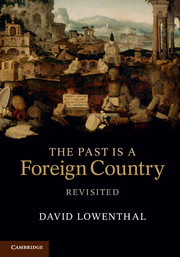Book contents
- Frontmatter
- Table of Contents
- List of illustrations
- List of permissions
- Acknowledgements
- List of abbreviations
- Introduction
- Part I Wanting the past
- Part II Disputing the past
- Part III Knowing the past
- Part IV Remaking the past
- 10 Saving the past: preservation and replication
- 11 Replacing the past: restoration and re-enactment
- 12 Improving the past
- Epilogue: the past in the present
- Select bibliography
- Index
- References
11 - Replacing the past: restoration and re-enactment
from Part IV - Remaking the past
Published online by Cambridge University Press: 05 November 2015
- Frontmatter
- Table of Contents
- List of illustrations
- List of permissions
- Acknowledgements
- List of abbreviations
- Introduction
- Part I Wanting the past
- Part II Disputing the past
- Part III Knowing the past
- Part IV Remaking the past
- 10 Saving the past: preservation and replication
- 11 Replacing the past: restoration and re-enactment
- 12 Improving the past
- Epilogue: the past in the present
- Select bibliography
- Index
- References
Summary
‘These old offices of ours, such as the Badgeries, are much more important as rituals than they were as realities. Like old churches, they are nostalgic, photogenic, and give a sense of security. Centuries ago, the Co-Wardens held every badger in the land, and they still do, technically, but with no badgers involved any more.’
‘Is there no immediate badger whatever? An occasional glimpse of one would serve as a foundation, though I admit that invisibility is a higher and more splendid challenge.’
‘There is a token badger maintained by the Yeomen of Hertford Forest. It is a stuffed one, of course.’
‘I suppose they let us take it on ceremonial occasions.’
‘Not the actual, token badger, except on the death of the Lord Royal. Normally, you get a clip of artificial fur set in an osier staff. This is an emblem of the token. A symbolic dog-rose [is] presented to you annually by the Knights of Egham.’
‘In short, what is not symbolic is emblematic?’
‘Except when it is token. Then, it is stuffed.’
‘Which of these – token, symbolical, or emblematical – applies to our annual ritual of Easing the Badger?’
‘All three. The stuffed, or token, boar-badger is inserted into a symbolic den and then eased out with your symbolical gold spade. In this way, there is no need actually to disturb any living badger.’ Vinson represented the spirit of English history and institutions. Carrying his token spade, he stood for everything whose demise was beyond dispute.
Nigel Dennis, 1955What if the past’s demise is indisputable? What if its forms and features are no more? Is there any way to bring them back? Can pasts that survive only in memory and memoir somehow be retrieved? History is full of efforts to recover bygone things and thoughts. Attempts to replace what has been lost are legion. Two types of retrieval are paramount. One is to restore what was once there; the other is to travel back to how things used to be.
Yearning for departed ancestors and bygone things takes two main routes, restoration and re-enactment. Both aim, as faithfully as possible, to reconstitute what has been recalled and recorded. Although the actual past remains unreachable, such simulacra may become laudable substitutes. Indeed, as the offspring of our own efforts, they may even feel superior to the original past they ostensibly replicate.
- Type
- Chapter
- Information
- The Past Is a Foreign Country – Revisited , pp. 464 - 496Publisher: Cambridge University PressPrint publication year: 2015
References
- 1
- Cited by

